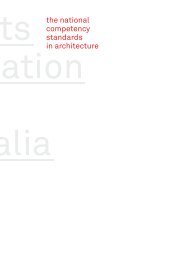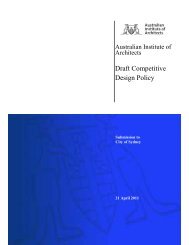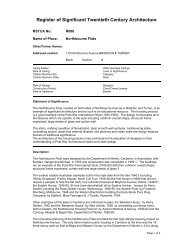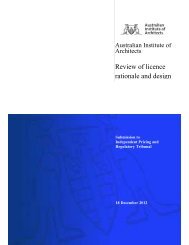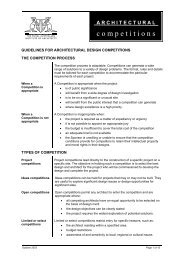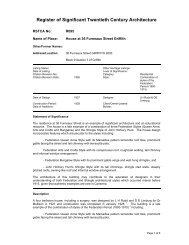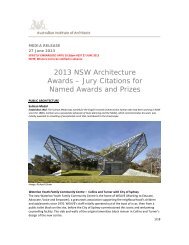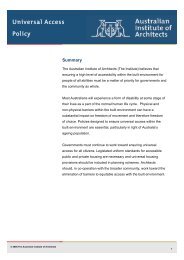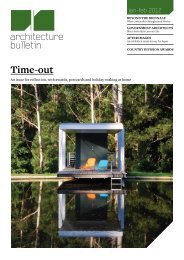SEPP 65 & Residential Flat Design Code Review - Australian ...
SEPP 65 & Residential Flat Design Code Review - Australian ...
SEPP 65 & Residential Flat Design Code Review - Australian ...
Create successful ePaper yourself
Turn your PDF publications into a flip-book with our unique Google optimized e-Paper software.
The <strong>Code</strong> is a guideline. The three crucial points of the process (see Page 1) provideadequate quality control with the possible inclusion of car parking as some Councilare requiring excessive car parking in areas considered well serviced by publictransport. This will require some input from other authorities.2.9 Is post approval compliance a significant issue with residential flatdevelopments? What measures could be introduced through <strong>SEPP</strong> <strong>65</strong> toensure design integrity is maintained?One of the objectives of the principles and <strong>Code</strong> is to enhance the integrity of thedesign process. Major changes during the development process need to be madeagainst those criteria. Ideally, the architect initiating the design should sign-off on theconstruction and occupation certificates. This is the best way of achieving designintegrity. Nevertheless, the Institute recognises that changes of developers andcreative personnel are often made. Under these circumstances it is critical that aregistered architect, who has either carried out the revisions or who has someindependence from the developer, endorses certificates. This is vital during Section96 applications presented to Councils and not reassessed by a DRP.2.10 Would it be beneficial to identify additional specific issues upon whichapplications cannot be refused? What issues should be covered this clause?Compliance with the principles and <strong>Code</strong> and endorsement by a design review panelshould mean that projects cannot be refused for design reasons. Often, however,councils will impose additional design changes without reference to the DRP that canchange the design integrity of a project.3 <strong>Design</strong> <strong>Review</strong> Panels3.2 What is a suitable number of panel members for a design review panel? Howoften should membership be reviewed and renewed? Should there be agreater ‘pool’ of panel members in each panel, with the minimum number ofrequired members drawn from these?A panel of three is a minimum. There should be the mandatory inclusion of anarchitect and a registered landscaped architect in each panel. Additional panelmembers, such as heritage experts, can be appointed and attend when required forspecific projects.Appointment of panel members is currently for 3 years. <strong>Review</strong>s should occur atleast every 3 years - or after a panel has commented on 20 proposals. Standingpanels should be required in urban and seafront locations with significant residentialflat development or potential with Council sharing panels as currently occurs; ‘roving’ad hoc panels could service regional areas with less intensive development.3.3 Should panels provide advice on design quality issues for applications otherthan residential flat developments under the <strong>SEPP</strong>? When consideringapplications for residential flat buildings, what is the extent of advice thatshould be provided? Should it be limited to matters covered in the <strong>Residential</strong><strong>Flat</strong> <strong>Design</strong> <strong>Code</strong>?<strong>Australian</strong> Institute of Architects (NSW)<strong>SEPP</strong> <strong>65</strong> & <strong>Residential</strong> <strong>Flat</strong> <strong>Design</strong> <strong>Code</strong> <strong>Review</strong>24 February 20126




